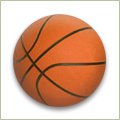
Recently, Nike and Kobe Bryant introduced their latest basketball shoe.
What's so special about them? They're not the usual high-tops we're used to seeing.
In fact, the low cut design brought back the argument about what type of shoe is best for basketball. Many experts have said that high tops are better at reducing ankle sprains (the most common injury in basketball), while others have said that high-tops limit performance.
During a recent interview with ESPN.com , Mr Bryant brought up lots of reasons for his decision to go to this new model.
- Soccer players cut harder and put more torque on their ankles than basketball players do, but they play in shoes lower cut than his new one.
- "High Tops were becoming more restrictive" and he wanted to make the shoe "as snug as possible" .
- "I've rolled my ankles a lot of times wearing high tops". Like his severe Right Ankle Sprain in 2005 .
- "If you come down on somebody's foot - there's nothing you can do about that"
- The current design "cuts the weight of the shoe"
- "gives your foot a little more freedom to change directions"
So what do I think? (Thanks for asking)
He's right about several things:
- Soccer players do cut hard and wear even lower-cut cleats.
- If you land awkwardly on someone else's foot, there's a good chance you'll turn your ankle regardless of the type of shoe you're wearing.
- A lighter shoe can help you jump (relatively) higher and move (somewhat) faster. Although I doubt it's going to significantly affect how tired you get on the court.
But Here's One Thing That Nike And Kobe Are Not Discussing - as reported in The Canadian Press , Kobe may be wearing a new low-cut shoe but "Bryant is sticking with plain old athletic tape for ankle support").
Why's that important? Taping ankles and/or wearing ankle supports has been shown to reduce the risk of ankle injuries (especially in athletes who have already injured their ankles before).
Just like the professional soccer players he watches and admires, Mr Bryant has a professional trainer at his disposal who will wrap his ankles before every practice and game.
Do you? Didn't think so.
Take Home Message Number 1
If you want to play in Kobe's low tops, either get someone to tape your ankles (will provide support for a limited time, depending on the type of tape and how it's applies) or put on an ankle support (will provide continuous support) before you hit the court.
Take Home Message Number 2
Regardless of what some people wear, they'll still sprain their ankles. Like Kobe says in his interview, "if you get crossed up, that's your fault" .









